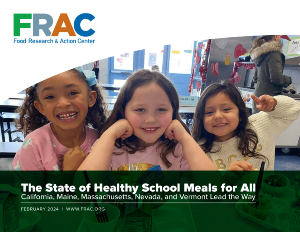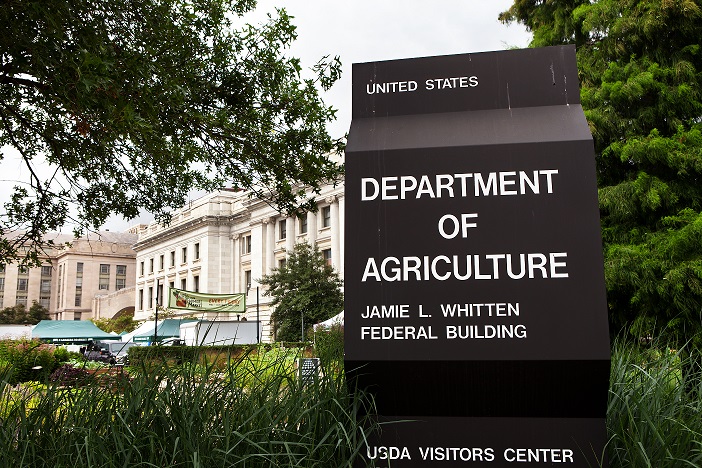The National School Lunch Program — the nation’s second largest food and nutrition assistance program behind SNAP — makes it possible for all school children in the United States to receive a nutritious lunch every school day. The vast majority of schools participate in the program, providing meals to 30 million children on an average day.
Quick Facts:
- Just over 28 million children participated in the National School Lunch Program on a typical day in the 2022–2023 school year, a decrease of nearly 1.8 million children compared to the 2021–2022 school year.
- 42 states and the District of Columbia saw a decrease in school meal participation in the 2022–2023 school year compared to the 2021–2022 school year, following the loss of pandemic-era waviers that allowed schools to serve all students school meals at no charge.
- The states that had increases in school meal participation in the 2022–2023 school year continued to offer meals to all students at no charge in all or a significant number of their schools.
- Any public school, nonprofit private school, or residential child care institution can participate in the program and receive federal funds for each meal served.
- Meals served through the National School Lunch Program meet federal nutrition standards, which require schools to serve more whole grains, fruits, and vegetables.
- The program is administered at the federal level by the U.S. Department of Agriculture (USDA) and in each state typically through the state department of education or agriculture.

The State of Healthy School Meals for All: California, Maine, Massachusetts, Nevada, and Vermont Lead the Way
School lunch participation in the five states that implemented Healthy School Meals for All policies during the 2022–2023 school year increased compared to prepandemic participation levels. Learn more in FRAC’s latest report, The State of Healthy School Meals for All: California, Maine, Massachusetts, Nevada, and Vermont Lead the Way.

Large School District Report: Operating School Nutrition Programs as the Nation Recovers From the Pandemic
Many large school districts across the country reported decreased participation in school breakfast and lunch when the nationwide child nutrition waiver that allowed schools to offer school meals to all of their students at no charge ended, according to FRAC’s latest report. Read Large School District Report: Operating School Nutrition Programs as the Nation Recovers From the Pandemic for more insights.

School Meals Participation Drops After Pandemic-Era Child Nutrition Waivers Expired
Read The Reach of School Breakfast and Lunch During the 2022–2023 School Year for more insights.

Community Eligibility: The Key to Hunger Free Schools, School Year 2022–2023
Community Eligibility: The Key to Hunger Free Schools finds that the number of schools participating in community eligibility grew by 15.8 percent from the 2021-2022 school year, with 82 percent of eligible schools participating. Nearly 20 million children in 40,235 schools and 6,419 school districts are participating and have access to school breakfast and lunch at no charge.

Reducing Barriers to Consuming School Meals
Too many students miss out on the important benefits of school lunch when barriers exist that prevent students from consuming all of their meal. This report includes best practices for school districts to maximize student participation and consumption in school meals.
- Benefits of School LunchA wide body of research supports the health and educational benefits of participation in the National School Lunch Program. Studies show that participation in school lunch reduces food insecurity, obesity rates, and poor health. Find out more about the benefits of school lunch participation.
- Eligibility and ReimbursementsLow-income children are eligible to receive meals for free or at a reduced price based on their household income or participation in other government programs like SNAP or Temporary Assistance for Needy Families (TANF). Children from moderate to higher-income households pay the school lunch fee set by the school district. Find out more about school meal eligibility and how children are certified for free and reduced-price school meals.
- Community Eligibility ProvisionCommunity eligibility allows high-poverty schools and districts to offer breakfast and lunch at no charge to all students. Schools that use community eligibility have seen increases in participation in school breakfast and school lunch and reduced administrative costs as community eligibility schools no longer have to collect school meals applications. Find out more about the Community Eligibility Provision.
- Unpaid School Meal FeesSchool breakfast and lunch provide students the nutrition they need in order to continue to learn throughout the school day. Students certified for reduced-price meals can be charged a maximum of 30 cents for breakfast and 40 cents for lunch, and those who are not certified for free or reduced-price school meals, generally are charged the cost of their meal. When students who are not certified for free school meals arrive in the cafeteria without cash in hand or in their school meal account, they can start to accrue school meal debt. School meal debt is a challenge for the majority of school districts — a recent school nutrition report found that 3 in 4 school districts had unpaid school meal debt. For more information on unpaid school meal fees, refer to these FRAC resources
- Every Student Succeeds ActThe Every Student Succeeds Act (ESSA) offers important opportunities for anti-hunger advocates to increase participation in the federal nutrition programs, particularly the school, summer, and afterschool nutrition programs. These programs are critical education supports, ensuring that students are well-nourished and able to focus, concentrate, and learn. Increasing student participation in these programs can help State Education Agencies (SEAs) and Local Education Agencies (LEAs — more commonly referred to as school districts) meet the goals of ESSA.
ESSA Resources:

School Lunch in Your State
To find out the agency that administers the National School Lunch Program in your state, check USDA’s list of state administering agencies.

